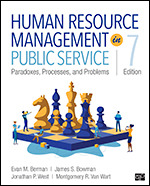Preface
Acknowledgments
Introduction
PART I • CONTEXT AND CHALLENGES
CHAPTER 1 • The Public Service Heritage: People, Process, and Purpose
A Day in the Life of Maria Hernandez
Some Challenges in Getting and Managing the Right People
The Structure and Role of Human Resource Departments
Historical and Institutional Context
Reforming Government in the Clinton, Bush, Obama, and Trump Years
Human Resource Management Principles
Ethics and Moral Management
CHAPTER 2 • Legal Rights and Responsibilities: Laws Governing the Workplace
The Foundations of Employment Law
The Employment Relationship
Balancing Employer, Employee, and Societal Interests
Pre-employment Investigations: Truth, Personality, Health, Credit, and Criminal Records
PART II • PROCESSES AND SKILLS: FROM START TO FINISH
CHAPTER 3 • Recruitment: From Passive Posting to Social Media Networking
Factors in Recruitment: Employer and Applicant Perspectives
Enhancing Recruitment Prospects: The Seeker’s Perspective
Advancing From Job Seeking to Career Development
CHAPTER 4 • Selection: From Civil Service Commissions to Decentralized Decision Making
The Bases and Origin of Selection
Criteria in Selecting Selection Tests
Selection: Four Screening Phases
Initial Reviewing and Testing
Interviewing and Reference Checks: Narrowing the Pool
General Considerations for Those Conducting Interviews
Post-offer and Hiring Issues
Appendix: The Professional Commitment Statement for Job Seekers
CHAPTER 5 • Position Management: Judicious Plan or Jigsaw Puzzle?
Three Types of Personnel Strategies
The Origins of Position Classification and Management
Job Design and Job Analysis
Job and Position Descriptions
Curbing, Cutting, and Eliminating Workforce
CHAPTER 6 • Employee Motivation: Possible, Probable, or Impossible?
Human Resource Management and the Climate for Motivation
CHAPTER 7 • Compensation: Vital, Visible, and Vicious
Equity and Expectancy Theory
Philosophy: Lead, Match, or Lag
Labor Market Forces: External Competition
Job Content: Internal Consistency
Individual Considerations: Fairness and Contributions
Appendix: Compensation for Graduate Degrees in Public Affairs and Administration
CHAPTER 8 • Employee-Friendly Policies: Fashionable, Flexible, and Fickle
Workforce and Workplace Trends
Health, Safety, and Wellness Programs
Flexible Work Arrangements
Traditional Benefits: Not-So-Employee-Friendly Trends
Implementation, Assessment, and Evaluation
Avoiding and Coping With Hostility at Work
Appendix A: Questions for Employees and Employers Regarding Telecommuting Arrangements
Appendix B: Some Questions to Answer When Considering Implementation of Employee-Friendly Policies
Appendix C: Family-Friendly Policies
CHAPTER 9 • Training and Development: Exploring New Frontiers
General Principles of Learning
Organizational Training and Development
Application: Ethics Training
Appendix: Needs Assessment and Evaluation for Training
CHAPTER 10 • Appraisal: A Process in Search of a Technique
Rating Errors: The Underbelly of Appraisals
Appendix: Corrective Actions
CHAPTER 11 • Unions and the Government: Protectors, Partners, and Punishers
Background: The Context and Evolution of Employee Relations
Differing Views of Unions
Paradoxes and Contradictions
Appendix A: Tips for Managers When Dealing With Unions
Appendix B: Tips for Unions When Dealing With Managers
CHAPTER 12 • Collective Bargaining: Structures, Strategies, and Skills
Structure, Representation, and Collective Bargaining
Bargaining-Related Reforms
Appendix A: Bargaining Checklist and Observation Sheet
Appendix B: Mock Disciplinary Appeal Board Hearing
CONCLUSION • The Future as Opportunity, Not Destiny
New Technologies, Human Competencies, Failures, and Reforms
Taking Responsibility for Paradoxes
Public Service as a Calling
Glossary
Index
About the Authors



